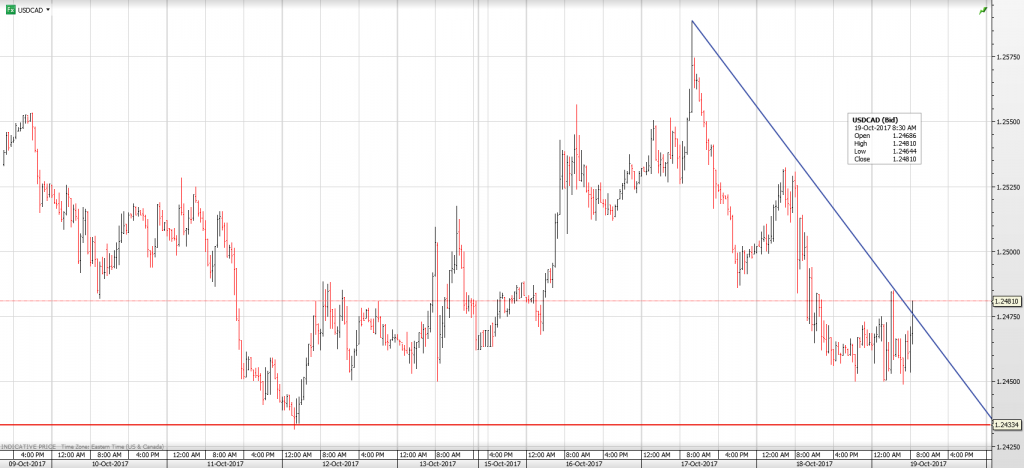The Canadian dollar is back from the brink. After “flirting with disaster” on Tuesday when USDCAD probed resistance at 1.2590, the currency pair is not looking at support in the 1.2430-40 area. Domestic influences did not have anything to do with the USDCAD decline although yesterday’s jump in August Manufacturing shipments to 1.6% from 1.0%, didn’t hurt.
This mornings firmer than expected US data, inserted a layer of support to the beleaguered US dollar. USDCAD popped to 1.2480 after Jobless claims (Actual 222,000 vs forecast 240,000) and Philadelphia Fed Manufacturing survey (Actual 27.9 vs forecast 22.0) handily beat estimates.
USDCAD traders are looking ahead to Friday’s Retail Sales and CPI reports. August Retail Sales is forecast to rise 0.5% vs July’s 0.4% result, in part because of high gasoline prices. September CPI is expected to gain 0.3% on the back of energy prices.
If the data surprises to the upside, USDCAD will extend losses to 1.2330. A worse than expected result would keep 1.2590 in play.
The New Zealand dollar was the worst performing currency overnight. NZ Labour leader Jacinda Ardern became Prime Minister.
She had a lot of help. New Zealand First party leader Winston Peter’s leveraged his party’s nine seats into 4 Cabinet positions while the Green Party got 3. The National Party has 56 seats out of 120, suggesting another election is just around the corner.
NZDUSD collapsed, dropping from 0.7169 to 0.7017 in New York.
AUDUSD rallied from 0.7842 to 0.7874 on a better-than-expected employment report. Australia gained 19,880 jobs (forecast 15, 000) and the Unemployment rate dipped to 5.5% from 5.6%.
It was a big day for China data. Q3 GDP was 6.8%, q/q, as expected. Industrial Production rose 6.6% (forecast 6.2%) and Retail Sales climbed 10.3% (forecast 10.2%).
In Japan, Prime Minister Abe and his party are well on their way to victory in Sunday’s election, meaning the status quo for Japan. USDJPY see-sawed in a 112.80-113.13 range on firm US Treasury yields. A whiff of risk aversion drove prices to 112..54 in early New York trading.
European traders are torn between ECB tapering expectations and fears of civil unrest in Spain. The Spanish government say’s it will invoke Article 155 of its Constitution on Saturday. The leader of Catalonia said they would vote for Independence. At the moment ECB concerns have won. EURUSD peaked at 1.1821 and traded to 1.1841 in New York.
Sterling is under pressure due to increased fears of a “hard” Brexit and weak Retail Sales Data (Actual -0.8% vs forecast -0.1%) GBPUSD dropped from 1.3227 to 1.3135.
USDCAD Technical outlook:
The intraday technicals are bearish while prices are below 1.2470 looking for a test of support in the 1.2430-40 area. A break of this level will extend losses to 1.2360, the uptrend line from the September 7 low of 1.2060. A break above 1.2470 will keep 1.2590 in play. For today, USDCAD support is in the 1.2430-40 area and then 1.2410. Resistance is at 1.2470 and 1.2510
Today’s Range 1.2415-1.2480
Chart: USDCAD 1 hour






